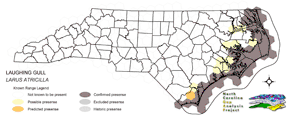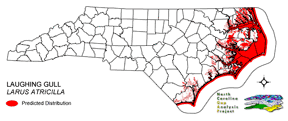
| Taxa: |
| Order: |
| Family: |
| Aves |
| Charadriiformes |
| Laridae |
| NatureServe Global Rank: |
| NatureServe State (NC) Rank: |
| G5 |
| S4B,SZN |
| Federal Status: |
| NC State Status: |
| --- |
| --- |


| Land Unit |
| US Fish & Wildlife Service |
| US Forest Service |
| US National Park Service |
| US Department of Defense |
| NC State Parks |
| NC University System |
| NC Wildlife Res. Com. |
| NC Forest Service |
| NC Div. of Coastal Mgmt. |
| Local Governments |
| Non-Governmental Org. |
| Other Public Lands |
| Private Lands |
| GAP Status 1-2 |
| All Protected Lands |
| Statewide |
| Hectares |
| 25,429.95 |
| 1,151.37 |
| 14,262.48 |
| 11,936.43 |
| 2,011.68 |
| 1,055.25 |
| 4,934.88 |
| 0.00 |
| 1,928.70 |
| 80.82 |
| 2,769.21 |
| 318.42 |
| 548,349.66 |
| 41,892.12 |
| 64,985.67 |
| 614,228.85 |
| Acres |
| 62,838.76 |
| 2,845.10 |
| 35,243.35 |
| 29,495.56 |
| 4,970.97 |
| 2,607.58 |
| 12,194.35 |
| 0.00 |
| 4,765.92 |
| 199.71 |
| 6,842.87 |
| 786.83 |
| 1,355,001.26 |
| 103,517.66 |
| 160,583.06 |
| 1,517,792.25 |
| % of Dist. on |
| Prot. Lands |
| 39.1 % |
| 1.8 % |
| 21.1 % |
| 18.4 % |
| 3.1 % |
| 1.6 % |
| 7.6 % |
| 0.0 % |
| 3.0 % |
| 4.3 % |
| 4.3 % |
| < 0.1 % |
| < 0.1 % |
| 64.5 % |
| ----- |
| ----- |
| % of Dist. on |
| All Lands |
| 4.1 % |
| 0.2 % |
| 2.3 % |
| 1.9 % |
| 0.3 % |
| 0.2 % |
| 0.8 % |
| 0.0 % |
| 0.3 % |
| < 0.1 % |
| 0.5 % |
| < 0.1 % |
| 89.3 % |
| 6.8 % |
| ----- |
| ----- |
|
Common along the coast and barrier islands (Fussell 1994). Large colonies breed on sandy beaches or in salt marshes. Of the 21 breeding colonies in North Carolina censused in 1981, 3 were in marshes and 18 on beaches (Portnoy et al. 1981). Will forage inland in wet pastures and agricultural fields and near human habitation. Will also follow ferries and boats in search of food (Farrand 1983). Nest is placed in grass, under bushes or between dunes, and often hidden by surrounding vegetation (Ehrlich et al. 1988). Grass is generally 2 or more feet high. Will breed with colonies of other species such as terns and Black Skimmers (Harrison 1975). NATURE SERVE GLOBAL HABITAT COMMENTS: Seacoasts, bays, estuaries, rarely on large inland bodies of water (AOU 1983). Large flocks rest on salt-pond dikes and sandspits (Costa Rica, Stiles and Skutch 1989). REPRODUCTIVE HABITAT COMMENTS: Choice of nest site flexible; in different areas may nest on salt marshes (New Jersey), dunes, beaches, shell and shingle ridges of coast and offshore islands, on ground in tall herbage or weeds, or among bushes (Puerto Rico) (Harrison 1978, Burger and Gochfield 1985). Along the northern Atlantic coast south to Massachusetts, nests usually on rocky islands in areas of dense AMMOPHILA & LATHYRUS or under and around MYRICA bushes. From New York to Virginia, nests almost exclusively on tidal salt marshes on or near mats of dead vegetation in tall grasses just above high-tide line. Farther south on Atlantic and Gulf coasts, nests on mats of SPARTINA or, more often, in drier areas on spoil islands or next to clumps of low vegetation in low swales between dunes. In extreme southern Florida, small colonies nest in interior sections of keys on open marl flats or among low herbaceous plants. (Spendelow and Patton 1988). |
| Code | Name | Description | NC Natural Heritage Program Equivalent |
| 378 | Ocean Beaches | Open beach sand. | Upper Beach |
| 3 | Tidal Marsh | Fresh and brackish tidal marshes, including cord grass, wild rice, sawgrass and needlerush alliances. | Brackish Marsh, Interdune pond, Maritime wet grassland |
| 124 | Maritime Scrubs and Tidal Shrublands | Coastal shrubs including wax-myrtle, swamp rose, alder, yaupon, and greenbriar. | Maritime Shrubs, Salt Shrub |
| 375 | Hypersaline coastal salt flats | Tidal flats within salt marshes, including saltmeadow cordgrass or sea-purslane dominated alliances. | Salt Marsh |
| 372 | Interdune Herbaceous Wetlands | Dune swales with permanently flooded to intermittently exposed hydrology. Species composition depends on salinity and can include cut grass, spike-rush, mosquito fern, and hornwort. | Interdune Pond, Maritime Wet Grasslands |
| 371 | Maritime Grasslands | Dune grass community consisting of sea oats and beach grasses. | Dune grass, Maritime dry grassland |
| 380 | Coastal Plain Fresh Water Emergent | Emergent vegetation in fresh water seepage bogs, ponds and riverbeds of the coastal plain. Includes alliances dominated by sedges, eelgrass, as well as cane found in unforested cane-brakes. | Small Depression Pond, Sandhill Seep, Floodplain Pool, Unforested Floodplain Canebrake, Riverscour Prairies, Vernal Pools |
| 180 | Agricultural Crop Fields | Farm fields used for row crops. | No equivalent |
| 205 | Agricultural Pasture/Hay and Natural Herbaceous | Farm fields used for pasture grass or hay production, as well as old fields dominated by native and exotic grasses. | No equivalent |
| 202 | Residential Urban | Includes vegetation interspersed in residential areas. Includes lawns, mixed species woodlots, and horticultural shrubs. Vegetation accounts for between 20 - 70% of the cover. | No equivalent |
| 203 | Urban Low-Intensity Developed | Highly developed areas with vegetation accounting for < 20% of the cover. | No equivalent |
| 8 | Open water | Open water without aquatic vegetation. | No equivalent |
|
Kepler, C. B. 1978. The breeding ecology of sea birds on Monito Island, Puerto Rico. Condor 80:72-87.
Bent, A.C. 1921. Life histories of North American gulls and terns. U.S. Natl. Mux. Bull. 113. Washington, D.C. Griffin, C. R., and E. M. Hoopes. 1992. Birds and the potential for bird strikes at John F. Kennedy International Airport. Final report, National Park Service, Boston, Massachusetts. 102 pp. Hagan, J.M., III, and D.W. Johnston, editors. 1992. Ecology and conservation of neotropical migrant landbirds. Smithsonian Institution Press, Washington, D.C. xiii + 609 pp. Sauer, J.R., and S. Droege. 1992. Geographical patterns in population trends of neotropical migrants in North America. Pages 26-42 in J.M. Hagan III and D.W. Johnston, editors. Ecology and conservation of neotropical migrant landbirds. Smithsonian Institu Belant, J. L., and R. A. Dolbeer. 1993. Population status of nesting laughing gulls in the United States 1977-1991. Am. Birds 47:220-224. Fussell, J.O. III. 1994. A birderís guide to coastal North Carolina. Chapel Hill and London: The University of North Carolina Press. Buckley, P. A., and F. G. Buckley. 1984. Seabirds of the north and middle Atlantic coast of the United States:their status and conservation. Pages 101-133 in Croxall et al., eds. Status and conservation of the world's seabirds. ICBP Tech. Pub. No. 2. Clapp, R. B., and P. A. Buckley. 1984. Status and conservation of seabirds in the southeastern United States. Pages 135-155 in Croxall et al., eds. Status and conservation of the world's seabirds. ICBP Tech. Pub. No. 2. Harrison, H.H. 1975. A field guide to bird's nests in the U.S. east of the Mississippi River. Houghton Mifflin Company, Boston, Massachusetts. 257 p. Harrison, C. 1978. A field guide to the nests, eggs and nestlings of North American birds. Collins, Cleveland, Ohio. Sprunt, A., IV. 1984. The status and conservation of seabirds of the Bahama Islands. Pages 157-168 in Croxall et al., eds. Status and conservation of the world's seabirds. ICBP Tech. Pub. No. 2. van Halewyn, R., and R. L. Norton. 1984. The status and conservation of seabirds in the Caribbean. Pages 169-222 in Croxall et al., eds. Status and conservation of the world's seabirds. ICBP Tech. Pub. No. 2. Burger, J., and M. Gochfield. 1985. Nest site selection bylaughing gulls:comparison of tropical colonies (Culebra, Puerto Rico) with temperate colonies (New Jersey). Condor 87:364-373. Terres, J.K. 1980. The Audubon Society encyclopedia of North American birds. Alfred A. Knopf, New York. American Ornithologists' Union (AOU), Committee on Classification and Nomenclature. 1983. Check-list of North American Birds. Sixth Edition. American Ornithologists' Union, Allen Press, Inc., Lawrence, Kansas. Farrand, J., editor. 1983. Audubon Society master guide to birding. Alfred A. Knopf, New York. 3 vols., 1244 pp. Raffaele, H.A. 1983. A guide to the birds of Puerto Rico and the Virgin Islands. Fondo Educativo Interamericano, San Juan, Puerto Rico. 255 pp. Ehrlich, P.R., D.S. Dobkin, and D. Wheye. 1988. The birder's handbook:a field guide to the natural history of North American birds. Simon and Shuster, Inc., New York. xxx + 785 pp. Spendelow, J.A., and S.R. Patton. 1988. National atlas of coastal waterbird colonies in the contiguous United States:1976-1982. U.S. Fish and Wildlife Service, Biological Report 88(5). x + 326 pp. Stiles, F.G., and A.F. Skutch. 1989. A guide to the birds of Costa Rica. Comstock Publ. Associates, Cornell University Press, Ithaca, New York. 511 pp. Portnoy, J.W., R.M. Erwin and T.W. Custer. 1981. Atlas of gull and tern colonies: North Carolina to Key West, Florida (including pelicans, cormorants and skimmers). Washington, D.C.: U.S. Fish and Wildlife Service, Office of Biological Services. FWS/OBS-80/05. 121p. |
For more information please contact them at:
NC-GAP Analysis Project
Dept. of Zoology, NCSU
Campus Box 7617
Raleigh, NC 27695-7617
(919) 513-2853
www.basic.ncsu.edu/ncgap